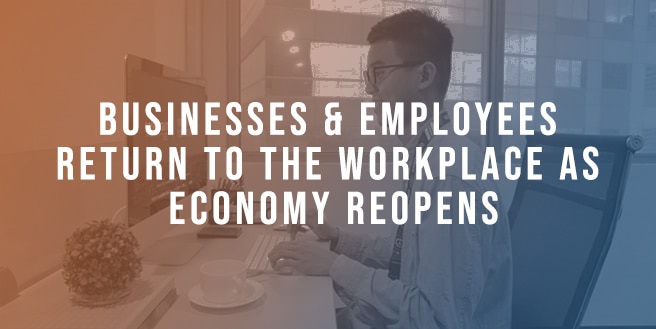Businesses & Employees Return to the Workplace as Economy Reopens

Businesses & Employees Return to the Workplace as Economy Reopens
Millions of employees began working from home when the COVID19 pandemic hit the globe in March 2020. Series of community lockdowns and restrictions have been imposed demanding nearly every individual to stay at home for months. From businesses closing down to people losing their jobs, this health crisis has clearly caused the most serious disruption to workplaces while continuously putting pressure on the global economy.
Alongside efforts to address the ongoing pandemic, country leaders have altered their way of working to ensure safety among its members and thrive amid the current circumstances. Business owners were forced to innovate and get creative in formulating solutions to accommodate a whole new set of requirements from its employees and clients. The year-long upheaval due to the COVID19 crisis made working from home the ‘new norm’ for many companies and professionals.
The Return of Employees in Workplaces
After months of uncertainty, a lot of business districts across the country were filled with teams of professionals striving for face-to-face collaboration and better social opportunities outside of their homes.
Today, as the pandemic situation improves and the vaccination rate increases, many business leaders are now getting ready for the ‘next normal’. From redesigning offices, adjusting work patterns to implementing flexible working arrangements, companies have started to welcome their employees back in the office.
However, it is important to note that although the economy is reopening, managing a post-COVID19 work environment requires a huge amount of planning and preparation. During this unprecedented time where maintaining social distancing has become a standard obligation for everyone, ensuring safe collaboration between employees is a must. Companies together with management leaders should establish effective communication and display an empathetic approach towards its members to help them physically and mentally adapt to the transition of working in the office.
Furthermore, flexibility and affordability are the main considerations as businesses return their workforce to offices. Many have opted for seat leasing to guarantee a healthy and productive place of work for their members without the upfront cost needed in developing infrastructure and supplying the needed furniture.
Why is Face-to-face Communication Important to the Economy?
You may be wondering: If remote work is possible, why bring the employees back to the workplace?
We are now living in a digital era, where technology has become an essential part of our daily lives. Video conferencing platforms and instant messaging applications continue to serve its purpose in facilitating online meetings and allowing people to communicate remotely. Work from home setup might have been a substantial discovery for most companies but this kind of arrangement doesn’t fit all types of businesses and transactions.
Despite efforts to adopt virtual ways of working, there is still a need for office spaces among various industries whose services require intensive physical interaction. There’s no denying that face-to-face collaboration plays a significant role in building partnerships and forming bonds between colleagues, making them motivated to engage more in their work. Moreover, coming back to the office after several months can make a difference in their productivity and growth.
Find the most flexible workspaces ideal for today’s modern requirements by contacting us today!




Leave a Reply
Want to join the discussion?Feel free to contribute!